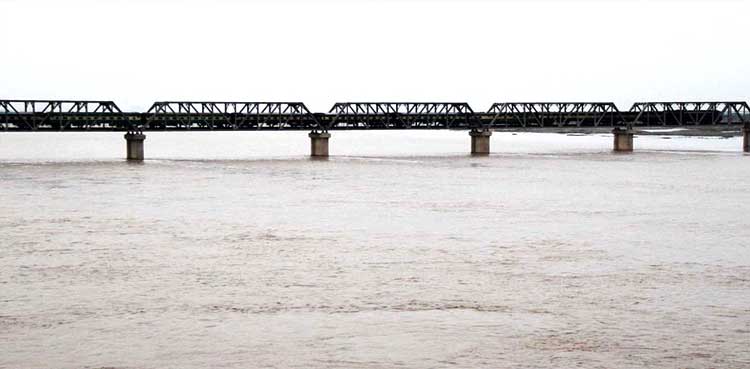River Chenab at Punjnad Headworks in Exceptionally High Flood, Threatening Sindh Downstream
LAHORE, PUNJAB – The River Chenab at Punjnad Headworks is experiencing an “exceptionally high flood,” with inflows and outflows surging to nearly 600,000 cusecs, exacerbating a regional crisis that has already submerged villages, destroyed crops, and displaced thousands. The floodwave, amplified by upstream releases from India and heavy monsoon rains, is now advancing toward Sindh’s barrages, prompting urgent evacuations and emergency measures.
🌊 Current Flood Status and Immediate Impact
Punjnad Headworks Crisis:
Water Flow: Inflows and outflows at Punjnad Headworks reached 446,820–600,000 cusecs, classified as “exceptionally high flood” levels.
Infrastructure Strain: All canals emerging from the headworks have been shut due to dangerous flow pressures, while embankments along the left and right margins are under strict monitoring.
Breaches and Submergence:
The Azmatpur dyke breached, submerging 5,000–6,000 acres of land and affecting villages like Azmatpur, Makhan Bela, and Chak Kahel.
In Liaquatpur, the collapse of the Zamindara embankment flooded homes and schools, trapping residents and necessitating rescue operations.
Human and Agricultural Toll:
55,000 people directly affected, with one confirmed death and widespread displacement.
Crops across 400,000+ acres inundated, exacerbating food security concerns.
⚠️ Causes and Contributing Factors
Upstream Releases from India:
India released 800,000 cusecs into the Chenab without prior warning, violating cross-border notification protocols under the Indus Waters Treaty.
Additional releases from the Salal Dam and other reservoirs compounded flood risks, particularly impacting Sialkot, Gujranwala, and Narowal districts.
Monsoon Intensity:
Punjab received 74% above-normal rainfall in August 2025, saturating river catchments and reducing absorption capacity.
The NDMA’s 10th monsoon spell (lasting until September 10) continues to trigger heavy rains, sustaining high river flows.
🚨 Regional Spread and Downstream Threats
Punjab’s River System:
Sutlej River: Facing “exceptionally high flood” at Ganda Singh Wala (311,000 cusecs), threatening Kasur and Okara.
Chenab Tributaries: Trimmu Barrage recorded 543,000 cusecs (high flood), while Marala Headworks saw 84,000 cusecs.
Sindh-Bound Floodwave:
The surge is expected to reach Guddu Barrage within 48 hours, where inflows are already at 366,151 cusecs (medium flood).
Sukkur and Kotri Barrages are also on high alert, with inflows at 329,990 cusecs and 245,000 cusecs, respectively.
🛟 Emergency Response and Evacuations
Rescue and Relief:
70,000 people and 169,000 livestock evacuated across Punjab, with 400+ relief camps and 500 medical camps operational.
Rescue operations prioritize Multan, Muzaffargarh, and Rajanpur, where villages remain partially submerged.
Infrastructure Measures:
Breaching Strategy: Authorities prepared to breach embankments at Khanki Headworks (if flows exceed 600,000 cusecs) to divert water and protect urban centers.
Machinery Deployment: Heavy equipment reinforces weak embankment spots, particularly along the Chenab’s left margin.
📊 Broader Implications and Risks
Economic and Food Security:
Punjab’s agricultural losses exceed 1.3 million acres of inundated land, threatening wheat and rice production.
Livestock losses (e.g., 6,180+ deaths nationwide) disrupt supply chains, potentially inflating food prices.
Transboundary Tensions:
India’s non-compliance with the Indus Waters Treaty’s data-sharing clauses has heightened bilateral strains, with Pakistani officials accusing India of “water aggression”.
Experts warn that climate change is rendering historical dam design parameters “obsolete,” necessitating revised cooperation frameworks.
🔮 Outlook and Recommendations
Short-Term:
Flood levels at Punjnad may exceed 500,000 cusecs within 24 hours, requiring sustained monitoring and preemptive evacuations.
Sindh must prepare for high inflows at Guddu and Sukkur, leveraging early warnings to minimize damage.
Long-Term:
Diplomatic Engagement: Revive bilateral dialogue to restore data sharing and equitable water management under the Indus Waters Treaty.
Infrastructure Investment: Strengthen embankments, expand real-time monitoring systems, and integrate climate resilience into flood governance.
💎 Conclusion
The exceptionally high flood at Punjnad Headworks underscores a compounding crisis driven by transboundary water releases, monsoon intensity, and infrastructural vulnerabilities. While emergency measures focus on immediate rescue and relief, sustainable solutions require reconciling diplomatic tensions with climate-adaptive governance. Pakistan’s disaster management agencies remain on high alert as the floodwave advances toward Sindh, emphasizing the need for coordinated regional action.







